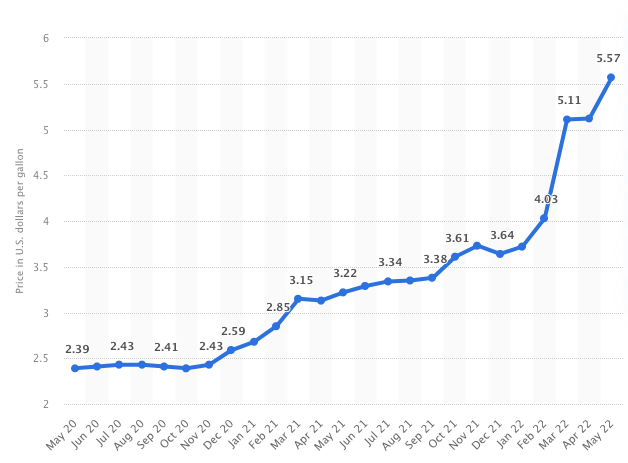Businesses across the manufacturing and logistics industry continue encountering challenges, from finding qualified employees to organizing their financial papers to match increased commodity prices. But the most problematic challenge that the industry is facing is the continuous rise in diesel costs in the past months. It is evident that a trucking company’s second greatest expense is diesel costs, and unfortunately, it is on the rise. Let’s look at how trucking companies are approaching high diesel prices in the United States.
Trucking Industry in the United States
Trucking is undoubtedly taken for granted despite the fact that it plays a vital role in the movement of everything that runs the nation. Approximately 3.5 million truck drivers in the United States transport nearly 70% of total freight tonnage at some point in the supply chain. It accounts for the majority of on-land freight movement in the United States, with gross freight revenues totaling $875.5 billion in 2021.
Different kinds of trucking companies
- General freight trucking: This type of trucking business transports a wide range of goods, including everything from food and clothing to electronics and building materials.
- Specialized freight trucking: This type of trucking business transports goods that require special handling, such as hazardous materials or oversized items.
- Refrigerated trucking: This type of trucking business transports goods that require temperature-controlled environments, such as food, pharmaceuticals, and other perishable goods.
- Tank trucking: This type of trucking business transports liquid or gas cargo in tanker trucks.
- Flatbed trucking: This type of trucking business transports goods that are too large or oddly shaped to fit in a standard trailer, such as construction equipment or large pieces of machinery.
- Dry van trucking: This type of trucking business transports goods in dry van trailers, which are enclosed trailers with no temperature control.
- LTL (less-than-truckload) trucking: This type of trucking business transports smaller shipments that do not require a full truckload.
- FTL (full-truckload) trucking: This type of trucking business transports large shipments that require the use of an entire truck.
- Intermodal trucking: This type of trucking business transports goods using multiple modes of transportation, such as trucks, trains, and ships.
- Private fleet trucking: This type of trucking business provides transportation services exclusively for a single company or organization.
According to recent statistics, trucks transport 72% of all freight in the United States. The trucking industry earned $875.5 billion in revenue in 2021. As of 2020, there were about 900,000 truck drivers employed in the U.S. Additionally, there were over 996,000 for-hire trucking carriers operating in the U.S. In 2021, U.S. trucks moved a total of 10.93 billion tons of freight.
Diesel Costs on the Rise
Nowadays, even if oil remains unchanged if the link between crude and diesel undergoes fundamental changes that add 10 to 15 cents per gallon to the spread, those gains will affect the retail price of diesel. As of May 2022, diesel fuel prices have reached an all-time high, climbing 18.15% and 57.85% from last year, averaging $5.57 per gallon nationwide. With an already uncertain and overburdened freight market, these sharply rising prices significantly impact fuel surcharges, transportation costs, and logistics budgets.

Shippers and carriers are preparing for the immediate impact of increased fuel prices and the possible long-term changes that will have to be made for those planning to thrive in the recession.
Trucking Companies Coping with High Diesel Prices
The business of transportation is complex in many aspects, including diesel costs. Owner-operators, long-haul drivers, flatbed truckers, tankers, and heavy haulers have various business approaches. What is beneficial to one person may not be beneficial to another, and vice versa. With that said, a lot of trucking companies are already dealing with higher fuel expenses and are bracing for more hikes in diesel prices. According to the US Department of Energy, average diesel prices have increased by more than 44 cents a gallon since the beginning of the year.
Given the many other factors affecting the trucking industry, there are various ways to manage the overall transportation cost:
Reducing Unnecessary Expenses
Reducing unnecessary spending is one of the first ways trucking companies deal with increased diesel rates. These include reduced empty miles, shorter idling periods, and better truck maintenance. By lowering these costs, truckers can save money on fuel and avoid losing business due to a big rate hike.
Organizing the trucks’ space and shipment locations.
More trucking companies are optimizing their shipments by transporting more loads with fewer trucks. They often examine their customers’ orders and shipments, determining if they can combine pickups and send a full truckload from each designated location. Whether it is still short on capacity, businesses communicate with their customers if they have other product requirements or if their shipment schedule is flexible enough to accommodate a full truckload.
Exploring New Markets and Customers
Diversifying the freight you haul or extending into new geographic areas is the best advice for those wishing to expand their customer base while minimizing the cost. Diversifying freight types might be difficult if it necessitates equipment upgrades. However, the most important point is that squeezing more value out of existing connections may not be the best strategy. That’s why finding new customers, new markets, and diversifying the kind of freight you transport is critical to maintaining stable growth.

